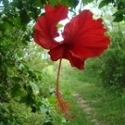|
This is the old OP, if you feel you can add something to it, LMK! Thanks!Synthbuttrange posted:Thanks to Desert Bus for getting the old thread started waaay back in 2008 (?!), and getting us started on a new thread. This OP is a collaborative and evolving thing, the work of Cowslips Warren, Fusillade, Desert Bus and myself, and hopefully it'll be updated with materials, corrections and FAQs that keep coming up. Desert Bus fucked around with this message at 00:15 on Sep 13, 2022 |
|
|
|

|
| # ? Apr 28, 2024 07:10 |
|
I have mostly freshwater but was gifted a marine tank back in May; the awesome serpent star, Event Horizon, died this week, which sucks because he was my favorite. But I was gifted some asterina starfish today so now I can have a ton of little fuckers all over the place. Also the live rock I bought from Petco (I had a gift card shut it) is covered with feather worms and now pineapple sponges. Kinda cool.
|
|
|
|
My pond goldfish are starting to finally change colour from dark brown to... something else. They've also started joining the adults in feeding time. Previous to this they always just did their own thing foraging for whatever naturally grows in the pond, but now they eating pellets with the big boys! I also accidentally dropped an entire deviled egg into the pond and the fuckers attacked it like piranhas. Just a chaos of splashing and biting until the egg was nothing more than a few chunks floating in a cloud of mayonnaise.
|
|
|
|
This thread title is worse than the last one because it seemingly excludes inverts? If I was new to the hobby with a shrimp tank or something I'm not sure I would think to check a thread called 'fish'. Unless this is a joke thread? e: sorry I guess it's a work in progress as per a comment in a different thread VelociBacon fucked around with this message at 23:35 on Sep 11, 2022 |
|
|
|
So I'm in a bit of a pickle. My mom recently passed and left a betta behind. Her partner has been taking care of the fish and when I went down for the funeral I decided to meet the fish. However his fins look nothing like my betta's fins. I'm wondering if it's fin rot or if some bettas naturally have fins like this. My mom never sent many pictures (and I'm in no state to look through her past messages to me) so I'm not sure if this is normal or not for this fish.   We're hoping to give the betta to my brother as my nieces are really interested in it and my brother is best suited in the area to take care of fish. However we don't want to give it to them only for it to die immediately because of fin rot or something.
|
|
|
|
Looks a lot like a crowntail betta to me, although even for a crowntail it does look a bit frayed, although it's hard to tell. Could be a water quality issue or could be that his fins are getting ragged from being in too much flow, or from mechanical damage from pushing past the plastic of the artificial plants. It could also be elderly, do you know how old he is? Probably a better indicator of his health is whether he's eating, whether he's swimming normally or hiding, and the fact that he's up at the glass giving you the eye looks to me like he feels fine. I'm sorry for your loss.
|
|
|
|
My understanding is that my mom got the fish a month or two ago at a Petco so I'm not sure of the age. The plants are silk instead of plastic so they shouldn't be tearing at his fins. He's swimming, hiding, sleeping, and eating normally. I guess he's fine and it's just normal. Thank you for the condolences.
|
|
|
|
Tangentially related, but is there any reason to buy silk/plastic plants unless you have like, koi fish that will eat them? Seems like silk plants are rough on fish, provide extra algae growing area, don't pull any nutrients out of the water, cost about the same price? I guess real plants occasionally shed leaves and need more light?
|
|
|
|
Pet stores tend to sell unsuitable but attractive looking plants, or emersed grown plants that are suitable but will lose all their leaves and take time to recover, or kits/tank sets with inadequate lighting, or maybe itís just that the local water isnít suitable or not knowing how to feed the plants that need it. Itís easy to buy a few plants, have them all die, feel like a failure then give up. Or to look at the cost and complexity of a CO2/high lighting set up and be overwhelmed or put off. Or sometimes itís just the immediacy of ďmy fish needs cover, I canít wait for this cutting to growĒ. Personally I went through so many different plants until I found the few basic and obvious species that grow well for me and give me free plants forever, and I understand why not everyone has the money or patience for that. Itís worth the effort though, I think live plants add so much to the stability of the tank through being an extra part of the biological filtration, adding surface area, and theyíre probably doing something beneficial in the substrate too with their root systems.
|
|
|
|
My parents have a loach. My dad says he kinda looks like a spaceship. That's all I got thanks for reading
|
|
|
|
burning swine posted:My parents have a loach. My dad says he kinda looks like a spaceship. They really do! I hope to get some hillstream loaches and this time, I will do it right. For now, I am gonna make sure I change water more often.
|
|
|
|
I have politely requested a thread title change and I 100% intend to update the OP soon, even if it is just a revamp of the old one.
|
|
|
|
 It's been ten years since my tank died of blue-green algae. I just didn't have the heart to try again. My tank and equipment has been languishing in a unused corner of the office ever since. I'm going to try again.
|
|
|
|
My tank has grown in a lot over the seven months since I set it up. Some of the plants grew much bigger and faster than I was led to expect. There's a monster echinodorus along the left edge of the tank and some red Cryptocoryne affinis that got 'yuge real fast and I dunno why (on the right behind the wood). I lost a mat of Riccardia (chancy without CO2 so not a huge surprise), and I have a couple Bolbitis that never really took though they're still alive. Interestingly the java ferns that were making babies like mad in the old tank aren't growing nearly as fast in the new one. May just be that there's more competition for nutrients in the water column, I guess. I don't see the kuhli loaches nearly as often as I used to before everything grew in which is kind of a bummer, though the corydoras still come out to swim around now and then. Probably shouldn't have put the crypts in front, but I thought they were going to stay smaller. On the plus side I didn't put any moss or floating plants in this tank so pruning is pretty easy and nothing is trying to blob and swallow the whole tank.   I've still just got regular rear end GE grow bulbs on the tank. I guess it might look nicer with an actual aquarium light but they seem to be expensive as gently caress for no particular reason. The snails seem to easily keep up with the algae growth except on the lid, which I have to wipe off once a month or so. So far it's much lower maintenance than the ~13 gallon I had prior. Stoca Zola posted:Or to look at the cost and complexity of a CO2/high lighting set up and be overwhelmed or put off. Or sometimes itís just the immediacy of ďmy fish needs cover, I canít wait for this cutting to growĒ. Personally I went through so many different plants until I found the few basic and obvious species that grow well for me and give me free plants forever, and I understand why not everyone has the money or patience for that. Most places that sell aquatic plants seem to do a pretty good job of explaining if the plant really needs extra CO2 or not. Aquatic plants seem pretty chill as long as you have an appropriate substrate. Of course if you already have a tank with sand and no plants and you're just feeding plants into it one at a time and watching them die I imagine that's pretty disheartening. Also seems like it's probably a lot easier to balance things out if you start with a lot of plants instead of just one or two. I will also say that I've only bought plants from two places (Buce and Aquarium Co-Op) and I've ended up with four different kinds of snails (in addition to the Nerites I put in on purpose) and god knows what else (pretty sure there's a small species of planaria in there though they don't seem to be bothering anything except the bladder snails). I like having them in there but I know some people really hate snails. Wallet fucked around with this message at 00:15 on Sep 13, 2022 |
|
|
|
In terms of planted tanks, I might be able to have something besides duckweed since my rice fish have discovered that scuds are in fact edible. I have scuds in most of my tanks, and contrary to popular belief, they have in fact destroyed hornwort, Java fern, Java moss, and Anubias. I suspect the only reason they have not decimated the duckweed is because it breeds faster than they do.
|
|
|
|
Cowslips Warren posted:I suspect the only reason they have not decimated the duckweed is because it breeds faster than they do. nothing breeds faster than duckweed
|
|
|
|
burning swine posted:nothing breeds faster than duckweed universe: challenge accepted. Found 4-5 bristleworms in my marine tank. Let's go.
|
|
|
|
Cowslips Warren posted:universe: challenge accepted. PHUO: bristle worms aren't a bad thing to have around
|
|
|
|
So in the pond now I have ~8 rosy reds, 12 killifish and 7 rice fish, I think the killifish and rice fish lay 20+ eggs a week, each, under normal pond conditions And then I have 3x 3-4" goldfish I just do not understand how fish survive in the wild. Two of the goldfish are pretty chill, but the fantail just wanders between the clumps of Java/Christmas moss I have glued down, presumably looking for How do any eggs manage to hatch in the wild? Is it just sheer number of eggs, that eventually one egg gets missed and not eaten, finally to hatch as a fry? And then what? The fry needs to somehow survive hiding in the plants and roots long enough to get big enough to outswim it's predators? I should just accept that I'll never have any full grown fish as descendants of my original pond stock, unless I put them in a breeding tank?
|
|
|
|
Iíve only seen fry ďin the wildĒ once, and that was in very shallow water at the edge, among emerging plants. For egg scattering fish itís a numbers game though, in good conditions theyíre capable of producing so many eggs every single day. Penguin tetras in captivity for example are so fecund that itís possible for the milt they produce in one spawning event to completely foul the tank. Egg laying fish ie ones that stick the eggs to a surface instead of pray and spray, tend to have strategies and preferred locations to lay their eggs, usually in thick plants or the underside of broad leaves, environments that provide cover for fry once theyíve hatched. And of course the other route to take is parental care, cichlids for example get extremely worked up to protect their fry. Fish spawning in extremely shallow water: https://youtu.be/vyAB3iNN6xI
|
|
|
|
My tank has been sitting dry for 10 years and I'm getting conflicting information on whether or not to reseal. Am I going to have to reseal it or is it fine if it doesn't leak?
|
|
|
|
Lareine posted:My tank has been sitting dry for 10 years and I'm getting conflicting information on whether or not to reseal. Am I going to have to reseal it or is it fine if it doesn't leak? You may not have to but since the tank is currently empty it seems like it's probably worth it. Having the silicone sit dry is, as I understand it, going to reduce its lifespan. If it's nearing the end it's certainly going to be a lot less of a headache to just reseal it now than have it start leaking in two years when your tank is really getting good.
|
|
|
|
Alright the algae didn't just magically disappear, so I guess I should do something about it.  It came in on some plants I stole from a local pond a few weeks ago. What do I do to get it gone? My tank is pretty stocked or I'd just throw some algae eating fish at it. I have 7 Tetras, 2 ghost shrimp, a betta, a 1in mystery snail, ½in ramshorn snail, and maybe a dozen snails smaller than a pea. I'd call it "medium planted"and I do half water changes weekly. Do I just scrape and what scraper do people like? I'm worried it might be bad for the snails shells or the shrimp if it gets too bad. Edit: unrelated: my betta hangs out at the bottom of the tank or between the air tubes and the glass and not on the betta leaf hammock I bought him at all. Do I need one of them floating betta logs so he feels safe at the top of the tank? Or should I just take my Java fern tunnel and hang it on the side instead of the bottom? RodShaft fucked around with this message at 15:29 on Sep 13, 2022 |
|
|
|
Everybody scrapes the glass, there is no way around it unless you keep the tank in an unlit, windowless room 24/7. Grab one of these and get to work! https://www.amazon.com/gp/product/B0072J7T2Y Be careful not to scrape the silicone in the corners. Best to use a paper towel to wipe along those seams. Talked to my boss today and got approval to bring a tank out to the office in my new job. I've got a low tech planted 29g set up at home with an angelfish, golden ram and siamese algae eater that I think I'll move out here. I've got easy access to a utility sink so should make water changes more bearable than last time I kept an office tank. Enos Cabell fucked around with this message at 15:56 on Sep 13, 2022 |
|
|
|
What is the overall take on pencil urchins in small Marine tanks? Reviews online seem to vary between they will eat everything and knock all kinds of cred over in your tank, to those reports are exaggerated and they're pretty chill but can move Coral around because they will roll them with their spikes. Seeing as I don't have any coral, I'm not worried about that, but I am a little concerned it might damage my feather worms or the pineapple sponges that have started developing on one of the rocks.
|
|
|
|
The weather warmed up so there's a box of fish in the mail with my name on it! I haven't had any new fish since I bought 20 kuhli loaches over 18 months ago. I'm getting some pristella tetras for my sister and some male guppies to split with her - she wants the longest fanciest tails and I just want some fresh genetics and extra males to help with my guppy colony's gender balance (almost all female after accidentally running the tank at a cooler temperature). I'm also getting a bunch of red fin danios for myself, I miss my zoomy zebras, I gave them away to a friend who has a bigger tank. There should be room for the new guys in the 4 foot tank with my rosy barbs. Lastly I am getting a half dozen ember tetras, as a trial. I found out one of my bigger tanks has been running with only a handful of shrimp and a single peacock gudgeon, so I've moved him in with the younger bunch in the grow out tank and he seems to love it there. I've been pulling shrimp from that tank to try to preserve whats left of that population because I think the gudgeons had been eating them. So I have a small tank in the kitchen that I think the ember tetras will suit, and if they do well I will get more of them and swap my rasboras from there into the bigger tank which is now virtually empty. The tank is due for an overhaul anyway, I've had that tank at almost floor level and I want to move it back up where I can see it and work on it more easily. I didn't realise my gudgeon population in there had shunk so much, I wonder if at some point a crayfish got in there and ate them?
|
|
|
|
The good news. I found where most of the rest of the stuff was. The bad news. It was being stored outside (thanks, Mom.) Luckily, most of the things ruined were chemicals that probably expired anyway. The big ticket item, my Eheim quick vac, works fine. I also found two unopened bags of substrate. A bag of Caribsea Eco-Complete Red and a bag of Seachem Flourite Black Sand. Things to get: aquarium-safe silicone, new filter media, new testing chemicals, root tabs, LED lighting. Things to do: Reseal tank, clean filter and heater, move tank downstairs. Question. Does Flourish and Flourish Iron expire? I'm reading that Flourish does degrade but Flourish Iron is just... iron, isn't it?
|
|
|
|
I've seen mould grow on some of my old unused ferts but I figure the worst that iron could do is react and precipitate out of solution. I've got an iron based additive that I've had for years without getting through the bottle and it seems pretty stable. No sign of box of fish yet, I think they missed the morning flight and are catching the afternoon plane. Hope the couriers don't get lazy and go home early or there could be a sad box of fish in a warehouse tonight.
|
|
|
|
Enos Cabell posted:Everybody scrapes the glass, there is no way around it unless you keep the tank in an unlit, windowless room 24/7. That came in today and I used the sponge end to clean the glass right before I did my water change. I didn't bother with the seams. Was way easier than I expected. I just rinsed The sponge end out in the sink. Let me know if it needs more care than that.
|
|
|
|
RodShaft posted:That came in today and I used the sponge end to clean the glass right before I did my water change. I didn't bother with the seams. Was way easier than I expected. I just rinsed The sponge end out in the sink. Let me know if it needs more care than that. Nope, that's all there is to it! Some people are super meticulous and do it every day almost, but I usually clean mine right before my weekly water changes.
|
|
|
|
Things to get: Things to do: Reseal tank, clean filter and heater, move tank downstairs. Local pet store didn't have any API master test kits but they did happen to have filter media. I am going to the Big Cityô on Saturday and I'll go to a real pet store and pick up a test kit and fertilizers and stuff. The big thing is the LED lighting and I honestly don't know where to start. I'm going for a moderate light tank for a 29 gallon. I think I'm going to try for the same plants as last time with a few substitutions. Plant list Myrio Red(I remember this being a real growslut) Pygmy Chain Sword(sub for dwarf sag because I didn't like what the sag was doing) Willow Hygro Anubias Nana Anubias Congensis Some kind of sword, preferably red. The anubias are low light, all the rest are moderate light. Thinking about trying a Finnex Planted + but I am pretty lost.
|
|
|
|
Finnex have only a 6 month warranty if Iím not mistaken. Mine certainly died quicker than I expected (it was the power unit not the LEDs). Iíve seen some comparisons with Hygger full spectrum and the light appears fairly comparable. Not sure whether itís better to go over-bright then leave the light on shorter, or under and leave it on longer.
|
|
|
|
Lareine posted:The anubias are low light, all the rest are moderate light. Thinking about trying a Finnex Planted + but I am pretty lost. I've been super happy with my Fluval Plant 3.0 lights. Have a pair of them up and running on my 75g high tech tank for a little over a year now and getting great results. I had a Finnex Planted+ that died within a year, so I recommend against those, but some people love them. (these are kinda old but I don't have more recent photos handy, tank is still doing great though) https://imgur.com/DHa3r7x.mp4 
|
|
|
|
Enos Cabell posted:I've been super happy with my Fluval Plant 3.0 lights. Have a pair of them up and running on my 75g high tech tank for a little over a year now and getting great results. I had a Finnex Planted+ that died within a year, so I recommend against those, but some people love them. Everyone seems to like the Fluval Plant 3.0 but it's a bit pricier. It DOES come with a 3 year warranty though. And it does have an app instead of an overly-complicated remote. Well, I've got something to think about while I'm resealing my tank tomorrow.
|
|
|
|
Also, I'm gonna sound odd to people, but the tetra test strips also work well instead of the master kit. I've found myself testing water more just because I'm not fiddling with every piece of a chemistry kit to learn my water's state.
|
|
|
|
I'm really digging how my indoor stock tank is growing in. Plants are absolutely loving their fish water.  Here's a shot of my on-the-mend reef tank that sits next to it. Starting to bounce back, but I'm still pretty gutted over the losses. 
|
|
|
|
Heh. Been reading up a bit on my prospective plant picks and I find out the red myrio is banned in several states for being a noxious weed. I guess that explains why it always did so well. As for the sword, I wanted something that would be both red and small. Hadi Red Pearl seems to fit the bill, too bad it seems to be sold out in a lot of places. I don't need plants right now though. I need to get my supplies and gear first. I think I want to get the Fluval Plant 3.0.
|
|
|
|
Box of fish was a whole day late! And it was kind of cold overnight. Turns out none of the tetras or danios minded at all, but it hit the guppies pretty hard. The albino/gold snakeskin guppies fared worse, with 3 deaths, meanwhile the red pigmented and black pigmented guppies came good after warming up. My sister's kids absolutely love the new guppies, they have named them Hitler, Pingu, Flame, Bubbles, Bit and Bot (Hitler has a moustache marking and was bullying the other fish) and my sister's pristella tetras loved the boost to their school size. My new ember tetras are bold and zoomy and having a great time with the rasboras, they like the flake food I tried but spat out the pellets. I'm not at all worried about feeding them now even though they're so tiny, and I don't really want to move the rasboras out of this tank now since they're all schooling together nicely. I think as the rasboras age out I will replace with more ember tetras, I've had some of these rasboras since 2015 and I'm not sure how long they're supposed to live.  The danios are kind of small and shy and extremely fast so I can't get pictures of them. I have the one surviving guppy that my sister's kids didn't take, he's got a red tail, black tuxedo body, and white face/veil top fin. He kind of looks a bit like a swimming bird poop from the side, but his white is really striking from above (maybe they call that colour platinum?). He's far too busy chasing girls to pose for a picture.
|
|
|
|
I wasn't able to finish sealing the tank today. It turns out to take significantly longer to remove the silicone when you only have a few loose razorblades. I got 7 out of 8 seams done. The index finger I was using to grip the blades STILL feels weird even hours later. And this is only cutting off most of it, I'm going to have to go back and scrape the glass and wipe it down with acetone. Super not fun, I can see why people are tempted to just buy new tanks.
|
|
|
|

|
| # ? Apr 28, 2024 07:10 |
|
Should we kill this thread and wait until someone makes a thread with a proper OP I'm in favor of periodically renewing megathreads, but it's extremely poor forums hygiene to have two competing megathreads with massively overlapping topics such as this Several other people have complained and this has been going on for too long now Please report this post, thanks. Preferably with a link to Rick astley: https://www.youtube.com/watch?v=dQw4w9WgXcQ
|
|
|









































